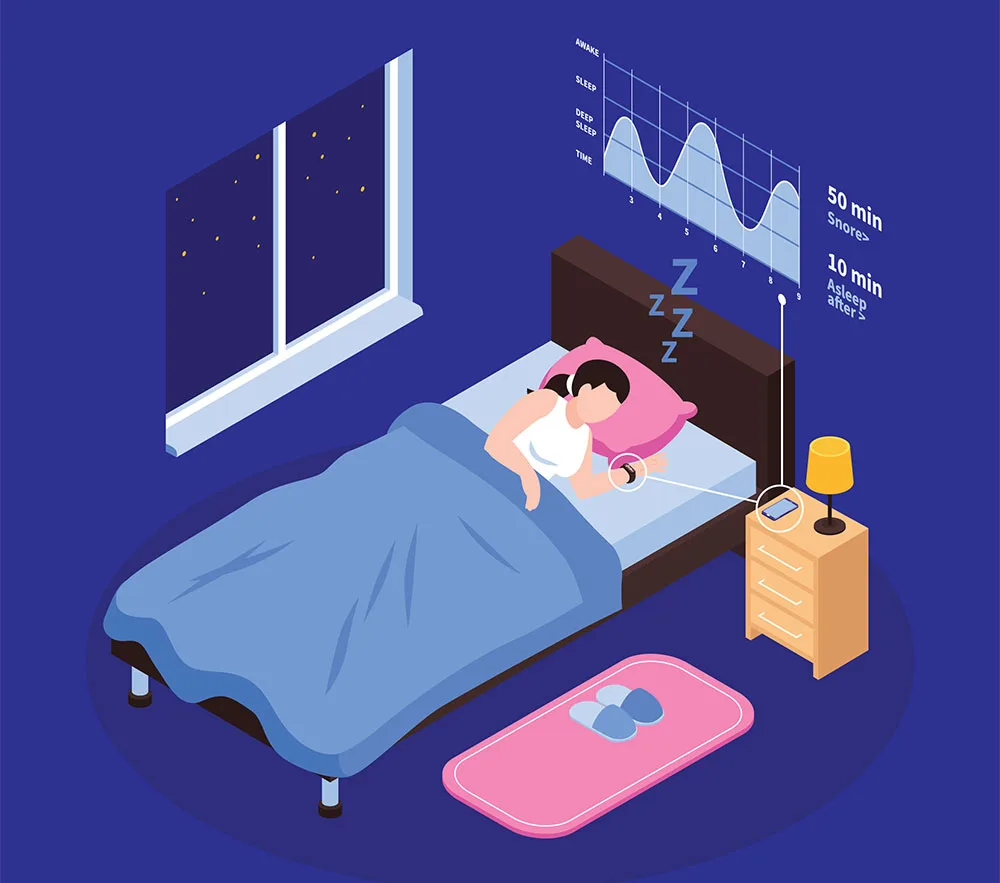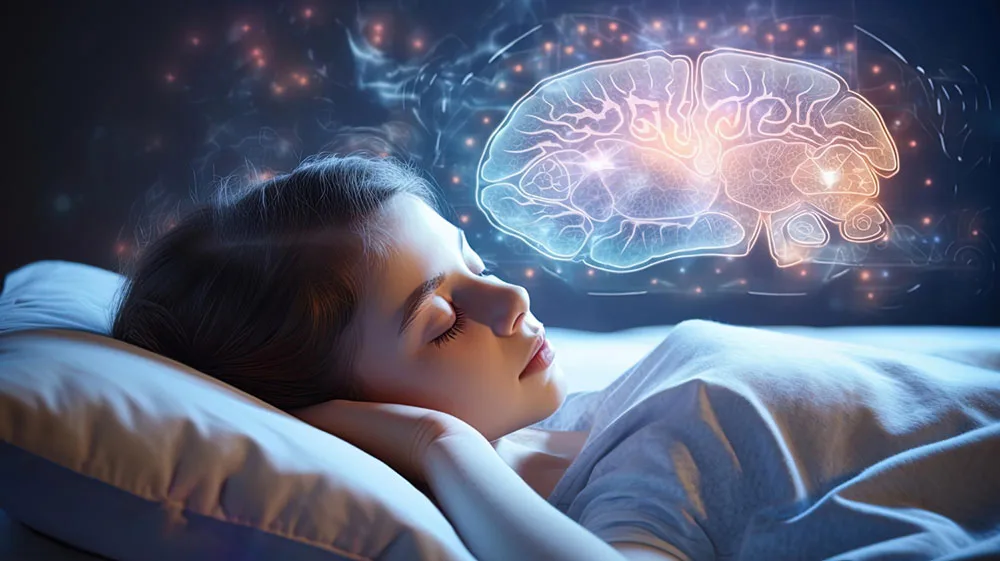Overview of Insomnia Diagnosis
Clinical history remains the gold standard for diagnosing insomnia. According to the DSM-5 and ICSD-3, chronic insomnia is defined by difficulties in initiating and/or maintaining sleep, or early waking, occurring at least three times per week over a three-month period without any external disruptive conditions and with daytime complaints.
Traditional Diagnostic Methods and Emerging Technologies
The primary test for diagnosing sleep disorders is polysomnography (PSG). However, it often fails to capture the prominent subjective differences between insomnia patients and healthy controls during a single laboratory night. Smart Wearable Sleep Trackers are emerging as valuable tools and smart health solutions in sleep medicine centers, significantly contributing to the field of digital health. Research has demonstrated the effectiveness of motion-sensitive wrist-worn wearable devices for distinguishing sleep from wakefulness, offering a non-invasive method for evaluating sleep quality and duration through movement monitoring. Parameters of sleep architecture, such as sleep efficiency, sleep latency, wakefulness after sleep onset, number of awakenings, and total sleep time, are derived using scoring algorithms applied to raw motor activity data. However, the validity of this approach for measuring certain sleep-wake parameters remains questionable, particularly in insomniac populations. Smart Wearable Sleep Trackers provide the advantage of lower costs for recording multiple nights compared to polysomnography. However, insomniac patients must remain still for extended periods while awake, leading to high false negatives in actigraphy.
Insomnia and Its Relationship with Other Diseases
The link between insomnia and other diseases has drawn increasing attention to sleep disorders over the past decades, including cardiovascular diseases, hypertension, thyroid cancer, obesity, cognitive decline, and depression. This relationship is bidirectional in cardiovascular disease: these disorders are both risk factors for insomnia and are exacerbated by it. Consequently, research has focused on physiological changes during different sleep phases, such as those in the cardiovascular system, body temperature, and sweating.
Wearable Devices and Their Efficacy
Smart Wearable Sleep Trackers have been found to overestimate sleep efficiency and total sleep time, as seen with devices like Fitbit, Jawbone Up, and Actiwatch Spectrum from Philips Respironics, thereby reducing sensitivity for detecting insomnia. Therefore, we opted to use one of the latest smartwatches, the Empatica E4, which records various biomarkers such as electrodermal activity, heart rate variability, and skin conductance, further advancing digital health solutions.
Physiological Indicators of Insomnia
Several studies, such as those by de Zambotti et al., report that insomnia patients exhibit increased parameters such as heart rate (HR), blood pressure (BP), metabolic rate, cortisol and norepinephrine concentrations, and body temperature. Heart rate variability (HRV) refers to the time difference between two consecutive heartbeats, also known as the RR interval. Previous studies have found discrepancies in heart rate across sleep stages, with heart rate even being proposed as a determinant parameter for sleep stages. The autonomic nervous system (ANS) changes function during NREM sleep, with a decline in sympathetic activity and a dominance of parasympathetic activity during N3 slow-wave sleep (SWS), where HR and BP reach their minimum levels, about 30% lower than during wakefulness. During REM sleep, there is significant HR and BP variability, with decreased parasympathetic activity and increased sympathetic activity, leading to abrupt heart rate changes and a high likelihood of arrhythmias. These abnormalities align with a state of functional hyperarousal induced by the sympathetic nervous system. Nonetheless, some studies question the reliability of HRV measurements in evaluating sympathetic activity in chronic insomnia.
Body Temperature and Circadian Rhythms
Body temperature is a stable exogenous marker with a 24-hour rhythm. Normally, it remains constant during the day but decreases slowly at the onset of sleep, reaching its lowest level near wakefulness, then rising rapidly. The peripheral temperature rhythm reflects the circadian system’s condition, with a pattern opposite to core temperature, which slightly but significantly decreases faster after lights off, resulting in a roughly 0.3°C lower temperature during sleep compared to quiet wakefulness. In humans, the minimum temperature usually occurs between 04:00 and 06:00 a.m. NREM sleep is characterized by elevated skin temperature, whereas REM sleep and wakefulness are associated with a decrease. Thus, there is an inverse relationship between temperature rhythm and melatonin levels.
Electrodermal Activity in Insomnia
Electrodermal activity (EDA) refers to changes in the skin’s electrical characteristics. Common measures include skin conductance, which reflects eccrine sweat gland activity, innervated by the sympathetic branch of the autonomic nervous system, primarily via sudomotor nerves. When sudomotor nerves activate sweat production, skin surface conductivity changes as sweat secretion and ionic permeability in the sweat gland membranes alter. The mechanism of EDA in insomnia patients is not well understood, but some studies indicate higher EDA, suggesting increased arousal.
The aim of this research was to describe potential differences in ANS activity in chronic insomnia patients compared to a control group using Smart Wearable Sleep Trackers and to determine if these results assist in diagnosing this condition. We assessed several device variables, relating them to clinical history and polysomnography findings, to identify variables supporting a diagnosis of chronic insomnia, thereby enhancing digital health approaches in sleep medicine.
Methodology
Thirty-two chronic insomnia patients and nineteen control subjects without sleep disorders were prospectively recruited. Both groups underwent an in-patient night with simultaneous polysomnography and Smart Wearable Sleep Trackers recording using the Empatica E4, which captured a range of physiological signals, including electrodermal activity, temperature, accelerometry, and photoplethysmography, for comprehensive sleep tracking and sleep monitoring.
Study Findings
Polysomnography showed that insomnia patients had significantly lower sleep efficiency and total sleep time, longer sleep latency, and increased wakefulness after sleep onset. Accelerometry revealed significant differences in the three axes (x, y, z) only in stage N3; no differences were observed in REM sleep between the groups. The lowest temperature was recorded during REM sleep in both groups. Unlike the control group, peripheral temperature did not decrease during different sleep phases in insomnia patients. Heart rate was higher in insomnia patients during both wakefulness and sleep stages. Heart rate variability was lower in stage N3 and higher in REM sleep compared to wakefulness in both groups. Insomnia patients had significantly higher sweating, as indicated by skin conductance variability and sudomotor nerve activity.
Conclusions
Our study suggests that sleep tracking and sleep monitoring with Smart Wearable Sleep Trackers reveals increased sympathetic activity in insomnia patients during sleep, especially in REM sleep and less so in SWS. These differences in ANS function may explain the higher cardiovascular disorder risk in insomnia patients. Smart Wearable Sleep Trackers are useful in outpatient settings to detect insomnia patients, highlighting their role in advancing digital health.
In a recent white paper, our colleague Marta Verona-Almeida with eesy-innovation GmbH and many more researchers delve into the fascinating world of dreams.
you can find the full article here.





